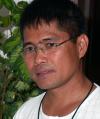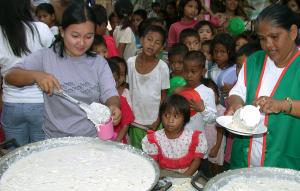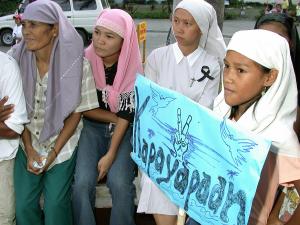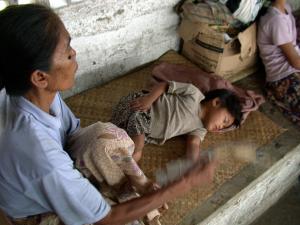Issue Date: April 11, 2003
A Space for Peace amid Philippines war CREATING a small space FOR PEACE Amid war, Philippine village resists historic prejudices By PAUL JEFFREY Not far away, the sounds of war are nearly omnipresent. Yet here it’s quiet, except for the laughter of children as they spin their wooden tops on the basketball court, which soon will be covered with rice harvested from the surrounding fields and raked out on the concrete to dry in the tropical sun. Just down the road a few miles the ferocity of war takes over, but here in this small “space for peace,” Muslims, Christians and indigenous people live together side by side with respect, actively resisting centuries of prejudice and challenging an international environment that would convert their village into part of a global battleground. Nalapaan is in the middle of Mindanao, the southern Philippines island that for centuries has been riven by ethnic, religious and economic conflict. Early this year the violence was renewed when a ruthless counterinsurgency campaign by the government military caused tens of thousands of people to flee their homes. In early March, a terrorist bomb exploded in a civilian airport in the provincial capital of Davao, killing 21 people and marking another ugly turn in the violence. Yet that well-reported violence isn’t the whole story of Mindanao. In a unique experiment, local Catholic peacemakers in the war zone have carved out a space where the rice that yellows as it nears maturity in the fields will soon be harvested by the same hands that sowed the seeds. For many rural residents victimized by the seemingly endless conflict, that’s a true definition of peace. “It was a crazy idea,” said Fr. Bert Layson, raising his voice to be heard as a helicopter passes low overhead, ferrying wounded and dead back from the war.
Layson is an Oblate of Mary Immaculate working in Pikit, a town smack dab in the middle of the conflict zone. He moved there in 1997 from the island of Jolo, in the Sulu archipelago, after rebels killed his bishop. Yet since arriving in Pikit, Layson has lived through four major military conflicts, and has supervised massive relief efforts as rural residents over and over again fled the fighting to take refuge in the town. Today, with 40,000 refugees in Pikit, including hundreds of displaced families once again filling his parish buildings and spilling into the yard in makeshift tents of bamboo and plastic, Layson knows intimately both the cost of war and the difficulties of making peace. “In 2000, the region had turned into a playground for people with guns, and we were taking care of 41,000 civilians. We were frustrated, and yet we somehow wanted to project that there was hope even in the middle of war,” he told NCR in an interview punctuated by artillery fire from a military encampment just down the road from his parish church. “So we decided to create a small space for peace, where people could return home to their village and feel safe. We wanted it to be not only a geographical space, but also a psychological and emotional one.” Layson consulted with refugee families, several of whom said they would be willing to go home if there was some guarantee they wouldn’t be caught again in the crossfire. Layson laid out his idea to local military officials, and then trekked into the mountains to discuss the plan with commanders of the Moro Islamic Liberation Front, a guerrilla army that has been fighting the Manila government since the 1970s. Layson proposed establishing a “space for peace” in three rural villages, zones where the two sides would agree not to fight. The Moro Islamic Liberation Front finally sent word they would support the proposal in just one of the villages Layson had suggested. It was Nalapaan, a notorious location from which the Liberation Front often staged attacks on government troops nearby. As a result, the military had attacked it repeatedly, burning homes, destroying the water system, and forcing residents to flee for Pikit while their crops rotted in the fields. Layson convinced the military to pull two of its four detachments out of the village, and got both the Liberation Front and the military to agree not to attack each other inside village boundaries. Layson persuaded several nongovernmental organizations to donate seeds and tools, and the 350 families of Nalapaan came home to plant their fields and rebuild their water system, homes and latrines. The residents of Nalapaan, two-thirds of whom are Muslim, also participated in an intensive peace education program run by the parish and supported by Catholic Relief Services (CRS), the overseas relief and development arm of the U.S. bishops’ conference. “This was the most important thing we did in the village, because it sought to restore the right relationship between the three groups in the community,” Layson said. “They evacuated the village as enemies, yet they returned as brothers and sisters to pick up the broken pieces together. In a year we transformed a shattered, grieving community into a peaceful village.”
Peace was contagious, and during the next two years five neighboring villages also declared themselves “spaces for peace.” Although the men with guns are still around, there have been no significant incidents. “We knew from the beginning we wouldn’t be able to get rid of the military completely, so the commitment from all sides is to not fight each other inside the village boundaries. The presence of the military isn’t an issue for the Moro Islamic Liberation Front as long as they don’t abuse the civilian population and protect the community from criminal elements like cattle rustlers,” said Layson. According to Myla Leguro, the manager of CRS’ peace building program in Mindanao, the success of people in Nalapaan and neighboring villages proves that peace is more than just the absence of war. “People demonstrated a true alternative to war that was more than just a cease-fire. Creating a space for peace has meant engaging in social rehabilitation as well as physical reconstruction, giving people a breather from war so that they can reestablish their livelihoods in a sustainable way and build the foundations for intercultural and interreligious cooperation,” she said. The island of Mindanao is home to some 20 million people, a quarter of the population of the Philippines. Although Mindonowans fall into three rough categories -- Muslim, Christian, and indigenous -- those categories are overlaid by myriad linguistic and regional affiliations that make Mindanao a complicated place. What is clear, however, is that Muslims and indigenous peoples are second-class citizens in a hierarchy first institutionalized by the Spanish, who brought the sword and cross to Mindanao centuries after Islam was introduced by Arab traders. This hierarchy was later strengthened by the United States, which sought to “pacify” the region’s “savage” peoples during its colonial rule, encouraging Christian migration from the north with racist programs of land reform. Nothing much has changed Since independence in 1946, nothing much has changed in Mindanao given the unambiguously Christian dominant culture and politics of the ruling elite in Manila. This tragic history came home to roost in the 1970s when civil war broke out between the Philippine military and Muslim separatists. The separatists now cheekily appropriated the prejudicial “Moro” label placed on them by the Spanish, who had battled for centuries to drive the Moors off the Iberian Peninsula. During the three decades since, the military has confronted more than a half-dozen organized insurgent groups, in the process leaving more than 100,000 people dead, millions displaced, and economic development permanently postponed in a region whose social indicators chronically lag behind the rest of the country. Yet just as militant Islam began remaking the region in its image during the 1970s and ’80s, progressive Catholics, encouraged by Vatican II, attempted to retune the church to the culture of the people. The Mindanao-Sulu Pastoral Council encouraged liturgical reform, an institutional option for the poor, and the establishment of Christian base communities. In the intervening years, however, especially after internecine leftist politics debilitated the movement, the Christian base communities “became more a name than a reality,” according to Archbishop Orlando Quevedo, also an Oblate, who heads the Cotabato archdiocese. When Quevedo, a native of Mindanao who is currently president of the country’s episcopal conference, moved back to Mindanao to take over the archdiocese four years ago, he set about rejuvenating the Christian base communities Quevedo used the Asian Integral Pastoral Approach, a program originally developed in South Africa but adapted by Asian bishops to accommodate Asian sensibilities and cultural values. “Rather than simply organizations, we wanted the [Christian base communities] to be a way of life, people in small groups coming together to pray and reflect on their own daily realities and to share with each other not just their time but their resources. These are poor people and in times of need they are supposed to help one another like in that small Christian community of Jerusalem in the Acts of the Apostles, where no one was rich and no one was poor because they shared with one another,” Quevedo told NCR. Given the demographics of Mindanao, a key element of the plan is interreligious dialogue at the grassroots, and Layson, whose parish belongs to Quevedo’s archdiocese, is the poster child for the effort. Yet Layson said it hasn’t been easy. “When I came here to manage the parish emergency response team, the parish leaders were so anti-Muslim they labeled me ‘Father Bert, OMILF’ [combining the initials of his order, Oblates of Mary Immaculate, and the Moro Islamic Liberation Front]. They said I was pro-rebel and pro-Muslim. I was grilled by the parish council, some of whom … wanted the church to help [only] Christian evacuees,” he said.
Standing his ground Layson stood his ground, though he had to tap his own bank account for relief monies when the parish treasurer refused to cooperate. Although two council members resigned, Layson said the rest eventually came around. “We conducted peace education in the parish, and now I don’t have any problems. I knew they were good Christians, but they’d had their own experiences of being harassed by Moro rebels, especially in the ’70s, and I can understand their feelings. Yet those who went through the seminars experienced a conversion of sorts, especially when we explained to them the history of Mindanao. They came to realize that it was they, the Christians, who were the strangers here. They thought they owned this land. Now they understand why many Muslims feel the way they do, why they have armed themselves. Many of them who were my critics are now peace advocates. We’ve created little spaces for peace inside their heads,” Layson said. Quevedo wants to replicate the Pikit experience in other parishes, yet acknowledges the resistance of many local religious leaders, including his own diocesan priests. “Many of my own priests have difficulty accepting Muslims. In the abstract they have no problems, but in the concrete, perhaps with their sad historical experiences, it’s difficult for them,” Quevedo said. Quevedo has tried to model interfaith dialogue by participating with several ulemas, or Muslim scholars, in the Bishops-Ulemas Forum, a formal dialogue among the region’s religious leaders, including Protestants. They meet regularly to discuss how issues of peace and reconciliation are fleshed out in each other’s scriptures. The most recent session, according to Quevedo, focused on Mary as “a possible point of convergence for Muslims and Christians, given that Muslims have great respect for Mary.” The dialogue has been made possible by what Quevedo characterizes as “low profile but very significant support” from Catholic Relief Services. According to Douglas Ryan, the CRS country representative in the Philippines, the shift from traditional forms of charity and food distribution to support for peace building efforts assisting the church’s efforts in the Philippines and throughout Asia of inculturation, interreligious dialogue, and a preferential option for the poor. Ryan said it has put the U.S.-based CRS “more in sync with the Asian church, and [made it] much more relevant in this country.” The dialogue is marred, however, by the absence of indigenous leaders, whose presence is reportedly opposed by the ulemas, who disqualify the indigenous for not being considered a world religion, nor having doctrines or sacred texts. That’s a critical weakness of the forum, according to Jesuit Fr. Alberto Alejo, a researcher at the Ateneo de Davao University. “Not only would indigenous leaders be able to offer valuable insights, they could also help tone down the polarity between the other two. For example, if the Muslims say the Christians were oppressors, the indigenous could tell the Muslims, ‘You also oppressed us, raided us and sold our men as slaves,’ ” Alejo told NCR. While Alejo approves of the dialogue at the top, he claims that intra-faith dialogue is more critically needed than inter-faith dialogue. “Some members of the Christian community will go as far as possible to dialogue with their Muslim counterparts. But are those who are liberal enough to dialogue with the Muslims equally willing to dialogue with the prejudiced mainstream of the Christian community? There are members of the Christian community who would readily finance military action against Muslims, but those at the front line of interfaith dialogue aren’t talking with these people. They say they carry out campaigns within the church to encourage the general Christian community to be more tolerant toward Muslims. In other words, they dialogue with Muslims but campaign [against] fellow Christians. Campaigns are not dialogue, they are unilateral discourse,” Alejo said. The Jesuit said a similar dynamic is true of Muslims. “The more progressive ulemas are dialoging with the more progressive bishops, but they are not listened to by the armed groups. Just as we are closing the gap between progressive Christians and progressive Muslims, we are widening the gap between liberal dialogically-minded people and prejudiced people on both sides,” Alejo said. Renewed fighting That bodes poorly for the region, which broke into open conflict again in early February. The government version of events maintains that the military went after a group called “the Pentagon.” According to the military, “the Pentagon” is a splinter group -- a so-called “lost command” -- of the Moro Islamic Liberation Front, which, like the infamous Abu Sayyaf Group in the Sulu archipelago, has traded ideology for banditry. Yet some suggest “the Pentagon” has clandestine links to the military; Alejo calls it “a kind of staged drama.” Whatever its initial explanation, soon the military was waging an ambitious campaign against the Moro Islamic Liberation Front and the refugees were pouring out of the mountains into Pikit and other nearby towns, where churches became emergency shelters once again. Pressed to explain the ferocity of their assault on an area known as the Buliok Complex near Pikit, where the Moro rebels had maintained several camps, the generals blamed the rebels for coddling “the Pentagon.” And following the convenient March 4 bombing of the Davao airport, military leaders and several politicians quickly blamed the Liberation Front, though there was no evidence linking the insurgent group to the blast. Liberation Front leaders quickly denied responsibility. Many observers discount the military’s explanation for the renewed fighting. Some suggest that the military is afraid of any final peace accord with the Liberation Front that will share the region’s natural wealth with Muslim communities. They point as an example to the Liguasan Marsh, an area outside Pikit rich in natural gas and other mineral deposits. Usmen Maongko, a Muslim peace activist in Pagalugan, told NCR that he served as a guide last year to Korean engineers carrying out tests for minerals in the Liguasan Marsh. He said engineers from Canada, Malaysia, and the United States have also been inspecting the marsh. According to Irene Santiago, a Catholic grassroots activist who sits on a four-member government panel negotiating with the Moro Islamic Liberation Front, significant progress had been made in peace talks in the preceding weeks, and a draft framework for a final peace treaty had been drawn up. Santiago said the panel discussed the document with government leaders Feb. 4, and scheduled meetings on Feb. 10 with leaders of the Philippine Congress. It was that day that the bombing of Liberation Front positions began. And, not surprisingly, once under attack, the front broke off talks. Santiago suggests the events in the Catholic north of the country, where politicians have long sought political advantage from attacking Muslims in the south, are behind the current difficulties. She points to the last major military campaign against the Liberation Front in 2000. “[President Joseph] Estrada’s popularity was dipping so he had this war against Muslims and became very popular afterward,” said Santiago. “This is a very anti-Muslim country.” Estrada’s war was run by Defense Minister Angelo Reyes, and Santiago says Reyes was present during the Feb. 4 meeting when the draft framework for the peace accords was discussed. In other words, he knew peace was about to break out. “I have no evidence, but I think that for Reyes war is simply a business. All this going back and forth to America and getting this and that. For him war is a business. And he has presidential ambitions,” Santiago said. While domestic politics have a lot to do with the renewed fighting, international pressures have not helped. A plan to send more than 1,700 U.S. troops on a combat mission to the southern Philippines hit a snag in late February when the government of President Gloria Macapagal Aroyo had to admit that such a role would violate her country’s constitution. Officials in Washington were angry that such a technicality would get in the way of what they perceive as a war on terrorism. According to Archbishop Quevedo, most Filipinos, himself included, would oppose U.S. troops coming to the Philippines for combat. While the issue is more nuanced if they’re coming only for training and so-called “humanitarian” activities, given the common reduction in this region of the U.S. conflict with Iraq to religious terms, the troops would inevitably aggravate interfaith relations in the south, no matter what their exact role.
Military might, religious claims “It looks like [President George W.] Bush is getting visions from heaven. He sees himself as a prophet from heaven. These religious overtones have serious political implications for the world, for when you combine military prowess with religious claims, you get a devastating intrusion in places like the southern Philippines,” said Alejo, the Jesuit researcher. Church leaders here are doing all they can to deconstruct the religious connotations of Bush’s crusade against Saddam Hussein. Frequent radio spots feature Quevedo, speaking on behalf of the country’s bishops, telling the public that Catholic leaders from the pope to their local bishop are against any war on Iraq. At the end of the day, the church may not be able to stop the violence raging around it and causing the poor to suffer. All it may be able to do is carve out little spaces for peace in some isolated communities and in the psyches of the faithful from all faiths. Fr. Layson is clear that even if the government and the Moro Islamic Liberation Front agree on a formal ceasefire and sign peace accords, the problems won’t have ended for Mindanao. “A final peace agreement won’t guarantee that there will be peace in the communities. As long as there is a war going on in the hearts of Christians, Muslims, and indigenous peoples, there isn’t going to be any peace here,” Layson said. “When you ask a young Moro boy what he wants to become when he grows up, he’ll tell you he wants to become an MILF rebel and fight the soldiers. A Christian boy will tell you he wants to become a soldier to fight the rebels. They are witnesses to war. They’ve grown up with helicopters and bombs. When they draw images during our psychosocial activities, they draw tanks, bombers, houses burning, people running away. These are not normal images for children. They carry these images in their mind,” said Layson. “Yet I’ve got 35 volunteers,” he
continued, “youth as young as 12 years old who help me with the evacuees,
and who defend them against those who don’t want to accept them in the
community. These young people inspire me. They’ve made space for peace in
their heads. It keeps me going, keeps me believing that peace is possible even
when it seems impossible. We’ve shown we can do it.”
National Catholic Reporter, April 11, 2003 |




